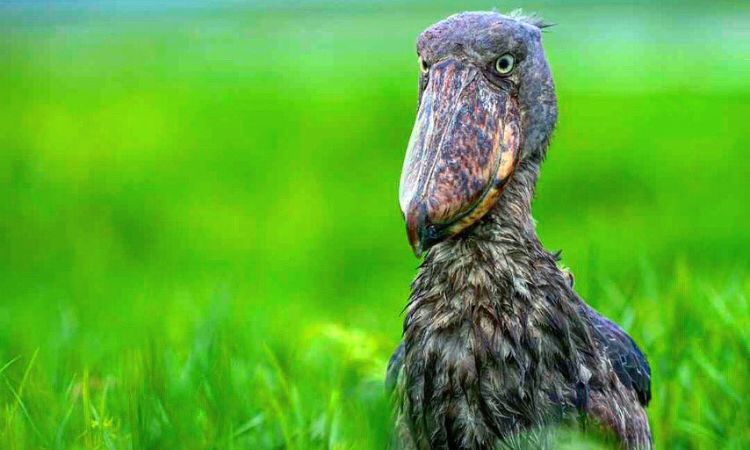Shoebill Stork Facts; Size, Location, Height, Diet + Videos
Shoebill Stork (Balaeniceps rex) are most popular as the whale-headed stork, shoe-billed stork, or whale-headed stork. The shoebill storks are large long-legged wading birds and take their name from their enormous shoe-shaped bills.
Shoebills feature shoe-shaped bills and originally, they were categorized under storks in the order Ciconiiformes. Currently, they fall in the category of pelicans and herons in the Pelecaniformes.
The adult shoebill features grey feathers and the young ones are brown. The Shoebills dominate the tropical East African vast swampy areas.
10 Interesting Facts about Shoebill Stork
Shoebill Stork Height
They are tall with a height measuring between 110 and 140 cm while others can grow up to 152 cm. Their tails range from 100 to 140 cm and their wings span from 230 to 260 cm.
Shoebill Stork Size
Shoebills weigh between 4 and 7 kg with males’ weight by average measures 5.6 kg. The males are slightly heavier than females that weigh about 4.9 kg.
The unique feature among Shoebills is their large, bulbous bills that are straw-colored with erratic greyish markings. The shoebill’s exposed culmen measures about 18.8 and 24 cm, ranked 3rd longest bill among the extant birds after pelicans and storks.

They have long legs with tarsus length measuring 21.7 to 25.5 cm. The feet are distinctly large with the middle toe measuring 16.8-18.5 cm. By nature, they are good hunters on aquatic vegetation.
The wings of Shoebills are broad featuring wing chord length of 58.8-78 cm. The plumage of adult birds is blue-grey and the darker slaty-grey flight feathers. The breast area has elongated feathers with dark shafts.
Shoebill Stork Sound
Shoebills are silent birds although they often bill-clatter while in their nests.
While clattering, adults utter a cow-kind of moo on a high pitch. During nesting season, adults and nestlings involve in bill-clattering- this is how they communicate with each other.
Shoebill Stork Flying Habits
When flying, Shoebill wings are held flat and they fly with their necks retracted. Their flapping rate is about 150 flaps per minute- making it the slowest rate among bird species.

The shoebills can fly for 100-500 meters and rarely take long flights.
Shoebill Stork Location (Distribution)
The Shoebill Storks live in freshwater swampy area of tropical Africa. These include Southern Sudan and South Sudan; Uganda, Rwanda, Western Tanzania, and Northern Zambia.

They also exist in Northern Cameroon, Kenya, Ethiopia, Upper Congo River, Malawi, Okavango Basin and others.
- Behavior
The Shoebill moves slowly and often stays still for longer time a reason they are often referred to as “statue-like” species. They are among sensitive species to human disturbance and can leave nests in case they are flushed by humans. They dominate the poorly oxygenated water areas, especially marshes, swamps and bogs where fish often surfaces to breathe.
- Breeding
The Shoebills are naturally solitary species. Unlike pelicans, cormorants and herons that nest in colonies, the shoebills use nests for breeding. The adults are responsible for defending the territory of about 2 to 4 sq.km from any conspecifics. Nesting often begins after rains end.
Incubation among shoebills takes about 30 days (approximately a month). The adults actively feed, guard, shade the nestling although the females are often more attentive. Mandibles play an important part in cooling the eggs with water during the hot weather, especially when temperatures are about 30 to 33 degrees celsius.
- Shoebill Storks’ Diet
The Shoebills are predominately piscivorous. They prey on lungfish, tilapia, and catfish as well as frogs, Nile monitors, water snakes, and baby crocodiles.

Considering their sharp-edged beaks, the Shoebills can hunt huge prey.
- Shoebill Stork Lifespan
Shoebills have an average life span of about 50 years. They reach maturity at 3-4 years. The breeding pairs are monogamous and co-parents, eggs, and juveniles are protected by both parents. Hatching often takes place after one month. About 3300-5300 adult shoebills still exist on planet earth.
- Where to find Shoebills in Uganda?
The best places to find shoebill Stork Uganda on a safari include Semuliki National Park, Mabamba Wetland/Swamp, Makanaga Swamp, Lugogo Swamp in Nakasongola, Murchison Falls National Park (around Lake Albert Delta), Ishasha sector in Queen Elizabeth National Park, Lake Mburo National Park, Uganda Wildlife Education Center, Lwera Swamp, Kyakakuza Swamp, and others.
In summary, over 1080 bird species live in Uganda alone making it a preferred birding safari destination. Shoebills are by far the most sought-for birds on every Uganda birding tour.
The 7 days bird Watching Safari Uganda takes you visit the greatest birding areas in Uganda such as Queen Elizabeth National park, Lake Bunyonyi which is one of the most bird…
The 10 days Uganda Safari Tour is an adventure packed long Uganda tour designed to give the best of Uganda vacations. This Africa safari involves gorilla trekking, bird watching…
Our 15 days Best of Uganda Safari involves the most adventurous tourist activities in Uganda e.g. gorilla trekking, bird watching, wildlife game viewing, chimpanzee trek…
FAQs about Shoebill Stork
It is estimated that about 3,000 to 5,000 shoebills are left in the world. This put this elusive bird on the list of the endangered animal species in the world.
Shoebills are known to be docile to humans with no known attacks to humans (generally). Note; do not threaten their peace due to their friendliness.
A fully grown shoebill stork can reach 1.524 meters (5 feet) tall with wingspan of up to 2.4384 (8 feet).
Yes, Shoebills can fly although not for a longer distance as compared to lighter birds.
Shoebill storks can be found in Uganda, Kenya, Cameroon, Central African Republic, Ethiopia, Malawi, Botswana and Congo.
Shoebills only attacks crocodiles for food and they attack the younger crocodiles.
Shoebills are carnivores and they feed on mainly lungfish, eels, catfish, Nile monitor lizards, snakes, small birds, and baby crocodiles.
